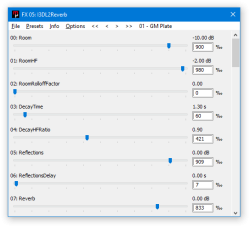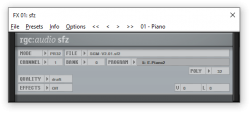Manual: Plugin Window


Plugins can be controlled through their plugin window. Many plugins come with a custom user interface (GUI) which is merely supported by OpenMPT′s menu bar, but there is also a variety of plugins which do not bring their own GUI. In this case, OpenMPT provides a default GUI, shown in the first screenshot on the right, which allows for controlling all plugin parameters. Custom plugin GUIs often provide better access to parameters, because they can be grouped visually, but at the same time they can get very complex and bloated.
Menus[edit]
File Menu[edit]
- Copy Preset: Copies the current preset to the clipboard, so that it can be pasted into another instance of the same plugin.
- Paste Preset: Pastes a preset from the clipboard.
- Load Preset / Bank: This allows you to load a single preset (FXP files) or preset bank (FXB files).
- Save Preset / Bank: This allows you to export the current preset / patch to a FXP file, or the complete bank to an FXB file.
- Create instrument from plugin: This command creates an instrument that is linked to this plugin.
- Randomize Parameters: This command randomizes all plugin parameters by a user-provided amount.
- Rename Plugin: This allows you to change the display name of this plugin instance.
Presets[edit]
If the plugin comes with a set of presets, you can choose one from this menu. Some plugins do not expose their presets to the host, in which case you can only change them from the plugin GUI or assigning a MIDI program.
Info[edit]
- In the Inputs sub menu, you can view all plugins that send their output to the current plugin′s input. Click any of the menu items to open the listed plugin′s editor. Additionally, all instruments which send sample and note data to this plugin are listed. If more than one instrument is assigned to the plugin, you can choose which instrument′s plugin settings should be used when triggering notes in the plugin editor by clicking the appropriate entry.
- Similarly, the Outputs sub menu shows which plugins receive the output of the current plugin.
- The Macros sub menu contains a list of all parametered Zxx macros. Macros that do not affect this plugin are greyed out, in contrast to macros that can be used to automate a parameter of this plugin. Currently unassigned macros are labeled with Learn Param. Plugin parameters can be assigned to such a macro by clicking its menu entry and then modifying the parameter in the plugin GUI — for example by clicking a knob, dragging a slider or whatever kinds of controls the plugin may offer.
Options[edit]
- Bypass Plugin: This option excludes the plugin from the processing chain. No audio is routed through the plugin if the option is checked.
- Record Parameter Changes: When changing a plugin parameter from the GUI, this change is written to the pattern using either Smooth MIDI Macros (\xx command in XM and IT tracks) or Parameter Control Events (in MPTM tracks). This is most useful when playing the module with the “Follow Song” option turned on.
- Record MIDI Out to Pattern Editor: For plugins that output MIDI data, this option can be used to route this MIDI data to OpenMPT’s pattern, sample and instrument editor.
- Pass Keys to Plugin: Some plugins need to process keyboard input, for example for entering a serial number or for typing in a preset name. Whenever this is necessary, you can enable this option to bypass OpenMPT′s keyboard handling.
Preset Switcher[edit]
If the plugin has any presets, the plugin switcher buttons can be used for quickly navigating between presets. Normal arrows dial the next or previous preset, while double arrows jump ten presets forward or backward.
Next to the switcher arrows, the current preset′s name is displayed. Clicking on it allows you to rename the preset. Note that not all plugins support this, and sometimes entering a new preset name has no effect.
Miscellaneous[edit]
Note Preview[edit]
Instrument plugins can be previewed directly in the plugin editor using the same note keys as in the pattern, sample and instrument editors. The instrument notes are sounded as long as you hold the appropriate note key. Additionally, an external MIDI device can send MIDI events to a focussed plugin window if the appropriate option is enabled in the MIDI Setup.
Controlling through external MIDI hardware[edit]
Plugin parameters may also be controlled by external MIDI hardware through MIDI Mapping. The MIDI Mapping dialog can be opened automatically by pressing Shift while modifying a parameter on the plugin′s editor.
Minimizing Plugin Windows[edit]
If you want to keep a plugin window ready for editing but do not want to have the actual editor cluttering your screen, you can double-click the window’s title bar to minimize it to its title bar. Double-clicking it another time restores it to its full size.